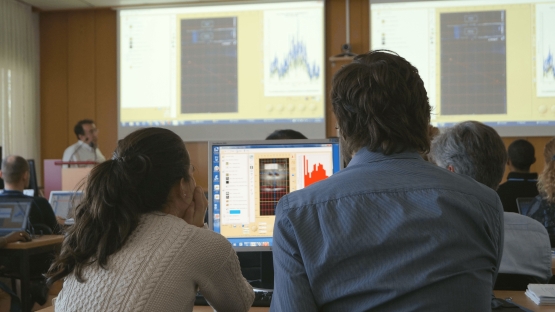A recently completed three-year IAEA Coordinated Research Project (CRP) (E24018) has successfully developed, pilot tested and adapted methodologies and procedures for dosimetry audits for advanced technology in radiotherapy dose delivery, on national levels.
Radiotherapy, one of the most widely used therapies for cancer treatment, uses different forms of radiation to harm and destroy tumours, either on its own or in combination with surgery or chemotherapy. Radiation dosimetry is the measurement and calculation of the ionizing radiation dose absorbed by the human body. Accuracy in dosimetry is important because even small differences from the prescribed radiation dosage can render the radiation treatment ineffective when too low, and can result in radiation injuries when too high. For this reason, regular, external audits are a crucial element in quality assurance (QA) programmes for clinical dosimetry in radiotherapy.
“Independent quality audits can be used to ensure that the quality of dosimetry practices in a radiotherapy centre is suitable for achieving the patient treatment objectives,” said the IAEA project’s lead Officer Joanna Izewska. “Quality audits are effective in identifying problems in clinical dosimetry. They bring them to the attention of medical physicists and provide support in finding the cause of the problems and help with resolving them.”
The project was carried out by national dosimetry audit networks (DAN) using small thermoluminescent dosimeters (TLD) and radiochromic films sent by post to audit advanced dosimetry technologies such as the increasingly popular intensity-modulated radiotherapy (IMRT). The CRP had two main objectives, the first of which was to independently verify advanced technologies in radiotherapy dose delivery for treatment of cancer patients to ensure the quality of the dosimetric chain in Member States. The second was to assist Member States in developing national quality audit programmes for radiotherapy dosimetry. In order to achieve these targets, four specific research objectives were determined:
- To develop and make available a methodology and procedures for national DANs for dose verification of advanced technology radiotherapy parameters used for cancer treatment;
- To develop and make available a methodology and procedures for national DANs for dose calculations for small fields and film-based dosimetry for MLC dosimetric and positional performance for IMRT;
- To develop and make available a methodology and procedures for national DANs for TLD and film-based dosimetry for single clinical IMRT field dose delivery;
- To develop and make available a methodology and procedures for national external audit groups (EAGs) for TLD-based and film-based dosimetry using an end to end approach – imaging, through planning and to dose delivery – for multiple field IMRT techniques.
In terms of the stated objectives, the CRP successfully achieved its aims and resulted in the development of relevant procedures which were tested in a multicentre study within the CRP and implemented at national levels through trial audit runs undertaken with radiotherapy centres.
“The CRP was very successful. It developed and tested new methodologies for independent dosimetry audits using end-to-end verification of radiotherapy dose delivery of advanced treatment techniques,” said Izewska. “Such a robust remote quality audit programme can effectively assist a radiotherapy centre in delivering accurate and safe radiation treatments, in particular as IMRT is being adopted for patient treatments in several Member States.”
The CRP has generated several positive impacts in participating Member States. For instance, it has increased radiation dosimetry expertise that could potentially reduce the number of dose misadministrations to radiotherapy patients. It has also enhanced confidence in the introduction of advanced radiotherapy technologies and treatments. Furthermore, experience with the practical methods and procedures to perform measurements of the advanced radiotherapy parameters has been made accessible to any DAN not participating in the CRP for implementation. The tools required and methods used during the course of the CRP can now be adopted by other national networks in a straightforward manner. Ultimately, large numbers of patients undergoing radiotherapy will benefit through receiving improved quality treatment with advanced radiotherapy technologies.
The CRP was implemented using eight research contracts and six agreements. An additional indication of the CRP’s success was that it generated 28 peer-reviewed publications including 19 conference proceedings and nine papers published in scientific journals. Further papers are in the pipeline.
“This CRP closes a cycle of four CRPs for independent dosimetry audit in radiotherapy where the philosophy was to begin with an audit of basic dosimetry, progressing to increasingly complex aspects of radiotherapy with the final CRP addressing audits of advanced treatment techniques,” said Izewska. “The success of this quality audit programme merits continuation to develop new audit modalities to keep pace with the rapidly evolving environment of radiotherapy technologies.”
With an eye to the future, several recommendations have resulted from this CRP. For instance, participants of research coordination meetings have expressed interest in the continuation of the IAEA CRP series involving national audits for dosimetry. Suggestions for follow up CRP topics currently under consideration include auditing dosimetry in brachytherapy, image guided radiotherapy, as well as stereotactic radiosurgery and stereotactic body radiation therapy.
The many ways nuclear technology is used to improve human health and quality of life will be discussed during November’s IAEA Ministerial Conference on Nuclear Science and Technology.





